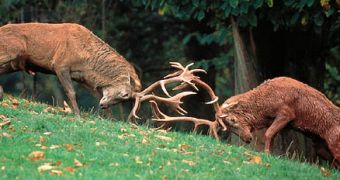1.The first deer appeared 50 million years ago. Eumeryx from Oligocene (35 million years ago) in Asia was devoid of antlers and had developed upper tusks, like modern day muntjacs. The first antlered deer appeared 20 MA ago: Dicroceros in Asia had simple antlers, forks on tall pivots.
About 2 MA ago, when clime turned colder, the steppes were inhabited by herds of giant deer with ramified antlers. The giant deer Megaceros inhabited the tundra of Europe and Asia during the Ice Age, until its end. The antlers had a span of 4 m (14 ft), and the animal was the largest deer ever. It went extinct with the reappearance of the forests.
2 million years ago, there also appeared the genus of the red deer and elk, Cervus. One group migrated through the Behring Land Bridge into North America, the other to North Africa (there was no Gibraltar). At the beginning of the first interglacial (Gunz-Mindel) and until its end, Cervus acoronatus was widespread. During the second interglacial, the red deer resembled the modern ones. About 400,000 years ago, a reduction of the canines generalized.
2.The red deer live in sexually segregated herds. Females live in groups of 5-40, larger during the winter in very populated areas. These herds can include males, 1-2 years of age, and are led by a fertile female. Males over 3 years make separated herds, of up to 12 individuals. In mixed herds, the males do not defend or guide the females. In the barren hills of Scotland, deer make herds of over 500 individuals. Deer are active especially in the morning and evening in quiet areas, while in populated areas they are mainly nocturnal. Deer are considered at their origin animals of open areas, and forests represent just refuges, related to the intensified human activity. Specialists do not consider the deer to be really adapted to forest life.
A family trio can include a female with the recent calf and the calf from the past year. The family needs 500-1,500 hectares, while a male 2,000-5,000 hectares.
3.The red deer consume soft food (grass) and hard food (twigs, offshoots, bark) for the intestinal transit. During the winter, the deer consume twigs, bark, and dead leaves, while during the fall they eat fruits, acorn and fungi. In the winter, they make altitudinal migrations, descending to the valleys. In areas with many red deer, there are less roe deer. At high densities, the red deer cause damages to the crops and impede forest regeneration.
4.The roar of the male during the rut triggers the female's ovulation. The mating lasts several seconds, and the estrus of the female about 24-48 hours. The male's antlers denote its hierarchical rank, growing more branches with the age.
The antlers are lost annually at the beginning of March, and start regenerating in an interval of 142 days (from March to the end of July), under the action of the sex hormones. The deer remains without antlers less than one month. The antlers do not tell us the precise age of the animal, but only if he is young, adult or elder. They also indicate the health state of the animal, as a wounded animal may have asymmetrical or deformed antlers. They also display the "mood" of the animal. Males live usually in groups of 2-3 individuals, and if one of them dies, his mates will grow weaker antlers!
Males do not eat during the breeding season and lose 25 to 30% of their weight.
The female eats the placenta after giving birth to eliminate the smell. She can defend the calf against foxes or wild boars by "boxing" with the fore limbs. Adults are attacked by wolves, bears, lynxes (females and calves), tigers, pumas, whereas the offspring are attacked by foxes, stray dogs, wild boars and eagles. The red deer's best defense is running, but the cornered adult will fight using its antlers and feet.
5.Up to 23 forms of red deer, Cervus elaphus, are known.
C.e.elaphus inhabits Western Europe, whereas the Eastern European deer (C.e.hippelaphus) inhabits central Europe and it is lager; the male reaches about 350 kg (740 pounds) in the Carpathian Mountains. This deer was introduced in Argentina and Chile for extensive growth. C.e.scoticus is the smallest and 270,000 individuals inhabit deforested areas of Scotland and England. This deer was introduced in New Zealand for extensive growth. C.e.hispanicus has short and light coat, and 100,000 individuals inhabit dry stony garriga in Spain. The small Corsican red deer (C.e.corsicanus) is represented by several hundreds of individuals in Sardinia and Corsica.
The Barbary stag (C.e.barbarus) has shorter legs and spotted coat. It inhabits northeastern Algeria and northern Tunisia. The Caspian red deer or Maral (C.e.maral) inhabits Asia Minor, Crimea, Caucasus Region and northwestern Iran.
The elk or wapiti (Cervus canadensis) from North America and Asia is considered now a distinct species. It can reach 450 kg (950 pounds), and the antlers can be 1.5 m (5 ft) long, having 12 branches. When Europeans entered North America, it lived from New York and Saint Lawrence River area to New Mexico and Alberta. Today it survives just in western US and Canada. The race of the Rocky Mountains is C.c.nelsoni and in the Pacific forests, from British Columbia to northern California lives C.c.roosvelti).

 14 DAY TRIAL //
14 DAY TRIAL //